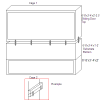What I've used as a sealant which is particularly good for monitors is a two part epoxy:
West Systems Epoxy. I lay it on the individual panels, laid flat, before I put the enclosure together. If you do it that way and use a spreader rather than a brush, a little goes a very long way. For lower sides and the bottom, which will come into direct contact with monitor claws, I've laid down a sheet of woven glass fibres (the material used for fibreglass, albeit with epoxy resin instead of polyester resin), poured the resin over the top and worked it flat with the spreader. It remains transparent, even with the glass fibres, so that the wood finish still shows through, but is incredibly tough. In the 5.5 years my adult lace monitors have been in their current enclosure they haven't yet managed to damage it.



